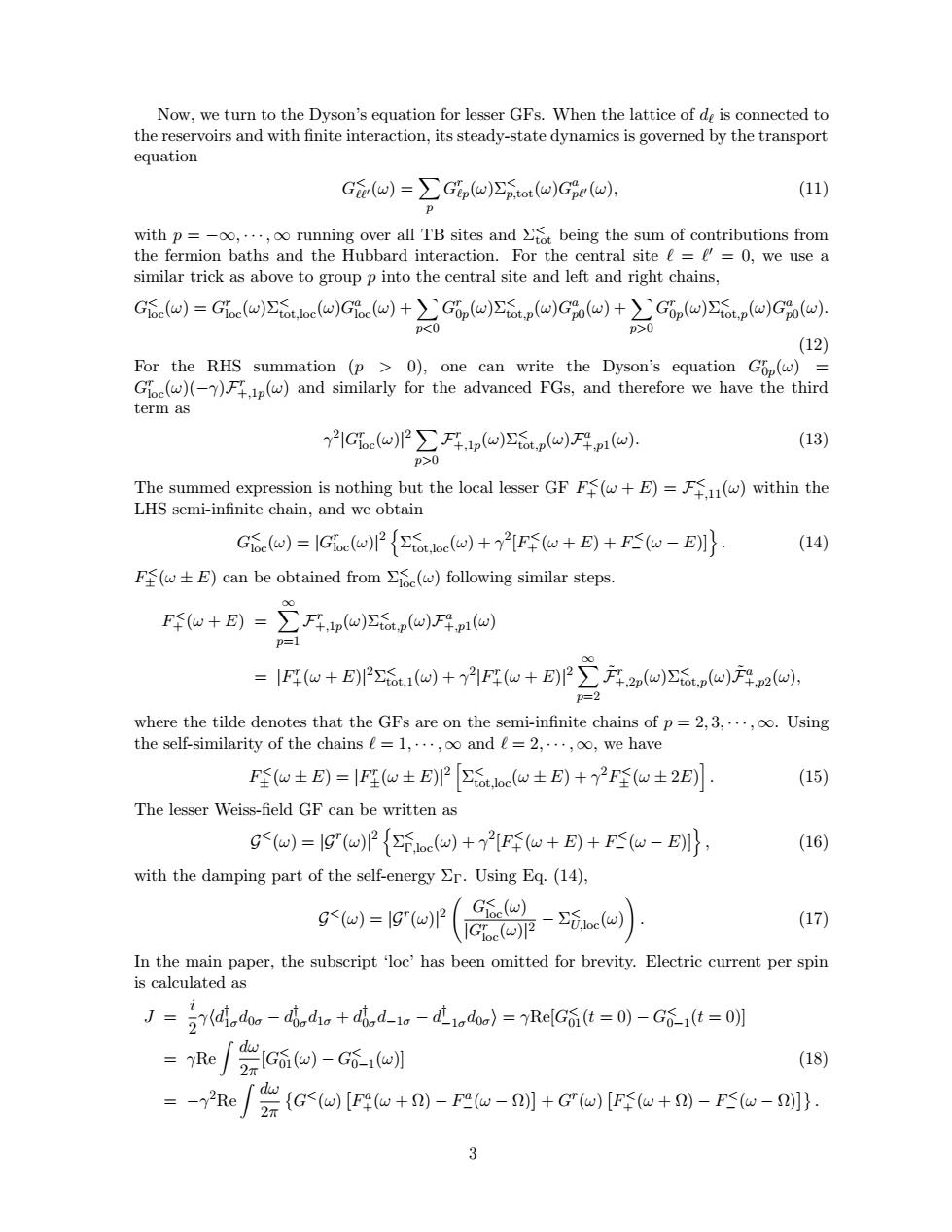正在加载图片...

Now,we turn to the Dyson's equation for lesser GFs.When the lattice of de is connected to the reservoirs and with finite interaction,its steady-state dynamics is governed by the transport equation G(u)=∑Gp(u)∑tot(a)Gge(u), (11) sum of contributions from teractio For th =0,we use a G()Gi.()i.+()) )Cpoww). (12) For the RHS summation (p 0),one can write the Dyson's equation Go(w)= Go))(w)and similarly for the advanced FGs,and therefore we have the third term as 2Gie()2F(w)(w)F(w). (13) B>0 The summed expression is nothing but the local lesser GF Fw+E)=Fw)within the LHS semi-infinite chain.and we obtain Gfe(w)=IGie(w){()+F(+E)+F5(w-E)]}. (14) Fw+E)can be obtained from (w)following similar steps e+月=Aoo回 =lF(u+E26.:u)+21Fu+E)∑F子.2p(u)6,p(a)年p2(w), =2 where the tilde denotes that the GFs are on the semi-infinite chains of p=2,3,...,oo.Using the self-similarity of the chains=1,.,oo and =2...,o,we have F坠w±E)=F(w±E)t(w±E)+F(w±2E) (15) The lesser Weiss-field GF can be written as G(o)=I9(2{fe(w)+Y2F吓w+E)+F匹w-EJ, (16) with the damping part of the self-energy Er.Using Eq.(14), gro-ar(意品-6 (17) In the main paper,the subscript loc'has been omitted for brevity.Electric current per spin is calculated as Jd doo dba di +dh d-do do)=Re[Gi (0)-G(0)] Re)- (18) =-Re (G()[F(+)-P2(-)]+G"(w)[F(w+-F5(w-]). 3Now, we turn to the Dyson’s equation for lesser GFs. When the lattice of d` is connected to the reservoirs and with finite interaction, its steady-state dynamics is governed by the transport equation G < ``0(ω) = X p G r `p(ω)Σ< p,tot(ω)G a p`0(ω), (11) with p = −∞, · · · , ∞ running over all TB sites and Σ< tot being the sum of contributions from the fermion baths and the Hubbard interaction. For the central site ` = ` 0 = 0, we use a similar trick as above to group p into the central site and left and right chains, G < loc(ω) = G r loc(ω)Σ< tot,loc(ω)G a loc(ω) + X p<0 G r 0p (ω)Σ< tot,p(ω)G a p0 (ω) + X p>0 G r 0p (ω)Σ< tot,p(ω)G a p0 (ω). (12) For the RHS summation (p > 0), one can write the Dyson’s equation Gr 0p (ω) = Gr loc(ω)(−γ)F r +,1p (ω) and similarly for the advanced FGs, and therefore we have the third term as γ 2 |G r loc(ω)| 2 X p>0 F r +,1p (ω)Σ< tot,p(ω)F a +,p1 (ω). (13) The summed expression is nothing but the local lesser GF F < + (ω + E) = F < +,11(ω) within the LHS semi-infinite chain, and we obtain G < loc(ω) = |G r loc(ω)| 2 n Σ < tot,loc(ω) + γ 2 [F < + (ω + E) + F < − (ω − E)]o . (14) F < ± (ω ± E) can be obtained from Σ< loc(ω) following similar steps. F < + (ω + E) = X∞ p=1 F r +,1p (ω)Σ< tot,p(ω)F a +,p1 (ω) = |F r +(ω + E)| 2Σ < tot,1 (ω) + γ 2 |F r +(ω + E)| 2 X∞ p=2 F˜r +,2p (ω)Σ< tot,p(ω)F˜a +,p2 (ω), where the tilde denotes that the GFs are on the semi-infinite chains of p = 2, 3, · · · , ∞. Using the self-similarity of the chains ` = 1, · · · , ∞ and ` = 2, · · · , ∞, we have F < ± (ω ± E) = |F r ±(ω ± E)| 2 h Σ < tot,loc(ω ± E) + γ 2F < ± (ω ± 2E) i . (15) The lesser Weiss-field GF can be written as G <(ω) = |Gr (ω)| 2 n Σ < Γ,loc(ω) + γ 2 [F < + (ω + E) + F < − (ω − E)]o , (16) with the damping part of the self-energy ΣΓ. Using Eq. (14), G <(ω) = |Gr (ω)| 2 G< loc(ω) |Gr loc(ω)| 2 − Σ < U,loc(ω) ! . (17) In the main paper, the subscript ‘loc’ has been omitted for brevity. Electric current per spin is calculated as J = i 2 γhd † 1σ d0σ − d † 0σ d1σ + d † 0σ d−1σ − d † −1σ d0σi = γRe[G < 01(t = 0) − G < 0−1 (t = 0)] = γRe Z dω 2π [G < 01(ω) − G < 0−1 (ω)] (18) = −γ 2Re Z dω 2π G <(ω) F a +(ω + Ω) − F a −(ω − Ω) + G r (ω) F < + (ω + Ω) − F < − (ω − Ω) . 3����